Atmospheric Heavy Metal Deposition in North Macedonia from 2002 to 2010 Studied by Moss Biomonitoring Technique
Abstract
1. Introduction
2. Materials and Methods
2.1. Study Area
2.2. Sampling and Sample Preparation
2.3. Statistical Methods
3. Results and Discussion
4. Conclusions
Author Contributions
Funding
Conflicts of Interest
Appendix A
| Al | As | Co | Cs | Fe | Hf | Na | Rb | Sc | Ta | Th | Ti | U | V | Zr | RE* | |
|---|---|---|---|---|---|---|---|---|---|---|---|---|---|---|---|---|
| Al | 1.00 | |||||||||||||||
| As | 0.76 | 1.00 | ||||||||||||||
| Co | 0.79 | 0.73 | 1.00 | |||||||||||||
| Cs | 0.83 | 0.83 | 0.77 | 1.00 | ||||||||||||
| Fe | 0.88 | 0.79 | 0.90 | 0.83 | 1.00 | |||||||||||
| Hf | 0.87 | 0.74 | 0.78 | 0.82 | 0.90 | 1.00 | ||||||||||
| Na | 0.77 | 0.64 | 0.70 | 0.74 | 0.76 | 0.78 | 1.00 | |||||||||
| Rb | 0.63 | 0.54 | 0.51 | 0.72 | 0.58 | 0.64 | 0.67 | 1.00 | ||||||||
| Sc | 0.89 | 0.80 | 0.89 | 0.86 | 0.96 | 0.90 | 0.79 | 0.59 | 1.00 | |||||||
| Ta | 0.87 | 0.74 | 0.78 | 0.85 | 0.84 | 0.90 | 0.82 | 0.72 | 0.89 | 1.00 | ||||||
| Th | 0.89 | 0.78 | 0.77 | 0.88 | 0.86 | 0.90 | 0.80 | 0.72 | 0.88 | 0.94 | 1.00 | |||||
| Ti | 0.84 | 0.57 | 0.69 | 0.66 | 0.77 | 0.73 | 0.62 | 0.51 | 0.75 | 0.70 | 0.71 | 1.00 | ||||
| U | 0.88 | 0.78 | 0.77 | 0.86 | 0.85 | 0.88 | 0.84 | 0.71 | 0.87 | 0.92 | 0.95 | 0.72 | 1.00 | |||
| V | 0.94 | 0.76 | 0.80 | 0.80 | 0.85 | 0.79 | 0.74 | 0.58 | 0.89 | 0.82 | 0.81 | 0.79 | 0.81 | 1.00 | ||
| Zr | 0.81 | 0.67 | 0.70 | 0.77 | 0.80 | 0.87 | 0.78 | 0.66 | 0.83 | 0.87 | 0.84 | 0.65 | 0.82 | 0.78 | 1.00 | |
| RE* | 0.91 | 0.77 | 0.81 | 0.83 | 0.91 | 0.92 | 0.77 | 0.68 | 0.91 | 0.88 | 0.92 | 0.75 | 0.90 | 0.84 | 0.83 | 1.00 |
| Ba | Br | Cd | Cr | I | K | Ni | Pb | Sb | Sr | Zn | |
|---|---|---|---|---|---|---|---|---|---|---|---|
| Ba | 1.00 | ||||||||||
| Br | 0.16 | 1.00 | |||||||||
| Cd | 0.04 | 0.11 | 1.00 | ||||||||
| Cr | 0.29 | 0.19 | 0.21 | 1.00 | |||||||
| I | 0.25 | 0.53 | 0.12 | 0.34 | 1.00 | ||||||
| K | 0.50 | −0.15 | 0.06 | 0.15 | −0.07 | 1.00 | |||||
| Ni | 0.16 | 0.18 | 0.33 | 0.71 | 0.41 | 0.01 | 1.00 | ||||
| Pb | 0.12 | 0.08 | 0.57 | 0.32 | 0.25 | 0.01 | 0.32 | 1.00 | |||
| Sb | 0.20 | −0.07 | 0.41 | 0.50 | 0.19 | 0.17 | 0.38 | 0.61 | 1.00 | ||
| Sr | 0.72 | 0.14 | 0.10 | 0.34 | 0.19 | 0.44 | 0.29 | 0.12 | 0.17 | 1.00 | |
| Zn | 0.17 | −0.06 | 0.51 | 0.49 | 0.12 | 0.33 | 0.45 | 0.61 | 0.74 | 0.15 | 1.00 |
References
- Barandovski, L.; Cekova, M.; Frontasyeva, M.V.; Pavlov, S.S.; Stafilov, T.; Steinnes, E.; Urumov, V. Air Pollution Studies in Macedonia Using the Moss Biomonitoring Technique, NAA, AAS, and GIS technology. Frank Lab. Neutron Phys. 2006. preprint. [Google Scholar]
- Barandovski, L.; Cekova, M.; Frontasyeva, M.V.; Pavlov, S.S.; Stafilov, T.; Steinnes, E.; Urumov, V. Atmospheric deposition of trace element pollutants in Macedonia studied by the moss biomonitoring technique. Environ. Monit. Assess. 2008, 138, 107–118. [Google Scholar] [CrossRef] [PubMed]
- Angelovska, S.; Stafilov, T.; Šajn, R.; Balabanova, B. Geogenic and anthropogenic moss responsiveness on lithological elements distribution around Pb-Zn ore deposit. Arch. Environ. Contam. Toxicol. 2016, 70, 487–505. [Google Scholar] [PubMed]
- Loppi, S.; Giomarelli, B.; Bargagli, R. Lichens and mosses as biomonitors of trace elements in a geothermal area (Mt. Amiata, Central Italy). Cryptogr. Mycol. 1999, 20, 119–126. [Google Scholar] [CrossRef]
- Kłos, A.; Ziembik, Z.; Rajfur, M.; Dołhańczuk-Śródka, A.; Bochenek, Z.; Bjerke, J.W.; Tommervik, H.; Zagajewski, B.; Ziółkowski, D.; Jerz, D.; et al. Using moss and lichens in biomonitoring of heavy-metal contamination of forest areas in southern and north-eastern Poland. Sci. Total Environ. 2018, 627, 438–449. [Google Scholar] [CrossRef] [PubMed]
- Barandovski, L. Use of passive biomonitoring and neutron activation analysis for deposition monitoring of trace elements in the air in the Republic of Macedonia. Ph.D. Thesis, Ss Cyril and Methodius University, Skopje, North Macedonia, 2014; 102p. (In Macedonian). [Google Scholar]
- Lazo, P.; Stafilov, T.; Qarri, F.; Allajbeu, S.; Bekteshi, L.; Frontasyeva, M.; Harmens, H. Spatial distribution and temporal trend of airborne trace metal deposition in Albania studied by moss biomonitoring. Ecol. Indic. 2019, 101, 1007–1017. [Google Scholar] [CrossRef]
- Stafilov, T.; Šajn, R.; Barandovski, L.; Bačeva, K.A.; Malinovska, S. Moss biomonitoring of atmospheric deposition study of minor and trace elements in Macedonia. Air Qual. Atmos. Health 2018, 11, 137–152. [Google Scholar] [CrossRef]
- Szczepaniak, K.; Biziuk, M. Aspects of the biomonitoring studies using mosses and lichens as indicators of metal pollution. Environ. Res. 2003, 93, 221–230. [Google Scholar] [CrossRef]
- Wróbel, Ł.; Dołhańczuk-Śródka, A.; Kłos, A.; Ziembik, Z. The activity concentration of post-Chernobyl 137Cs in the area of the Opole Anomaly (southern Poland). Environ. Monit. Assess. 2015, 187, 1–7. [Google Scholar] [CrossRef]
- Dołhańczuk-Śródka, A.; Ziembik, Z.; Kříž, J.; Hyšplerova, L.; Wacławek, M. Pb-210 isotope as a pollutant emission indicator. Ecol. Chem. Eng. S 2015, 22, 73–81. [Google Scholar]
- Groet, S.S. Regional and local variations in heavy metal concentrations of bryophytes in the northeastern United States. Oikos 1976, 27, 445–456. [Google Scholar] [CrossRef]
- Percy, K.E. Heavy metal and sulphur concentrations in Sphagnum magellanicum Brid. in the maritime provinces, Canada. Water Air Soil Pollut. 1982, 19, 341–349. [Google Scholar]
- Rühling, Å.; Steinnes, E. Atmospheric Heavy Metal Deposition in Europe 1995–1996; Nordic Council of Ministers: Copenhagen, Denmark, 1998. [Google Scholar]
- Wolterbeek, H.T. Biomonitoring of trace element air pollution: Principles, possibilities and perspectives. Environ. Pollut. 2002, 120, 11–21. [Google Scholar] [CrossRef]
- Lee, C.S.L.; Li, X.; Zhang, G.; Peng, X.; Zhang, L. Biomonitoring of trace metals in the atmosphere using moss (Hypnum plumaeforme) in the Nanling Mountains and the Pearl River Delta, Southern China. Atmos. Environ. 2005, 39, 397–407. [Google Scholar] [CrossRef]
- Elias, C.; Fernandes, E.A.N.; França, E.J.; Bacchi, M.A.; Tagliaferro, F.S. Native bromeliads as biomonitors of airborne chemical elements in a Brazilian resting forest. J. Radioanal. Nucl. Chem. 2008, 278, 423–427. [Google Scholar] [CrossRef]
- Harmens, H.; Norris, D.A.; Steinnes, E.; Kubin, E.; Piispanen, J.; Alber, R.; Aleksiayenak, Y.; Blum, O.; Coşkun, M.; Dam, M.; et al. Mosses as biomonitors of atmospheric heavy metal deposition: Spatial and temporal trends in Europe. Environ. Pollut. 2010, 158, 3144–3156. [Google Scholar] [CrossRef]
- Harmens, H.; Norris, D.A.; Sharps, K.; Mills, G.; Alber, R.; Aleksiayenak, Y.; Blum, O.; Cucu-Man, S.M.; Dam, M.; De Temmerman, L.; et al. Heavy metal and nitrogen concentrations in mosses are declining across Europe whilst some “hotspots” remain in 2010. Environ. Pollut. 2015, 200, 93–104. [Google Scholar] [CrossRef]
- Harmens, H.; Buse, A.; Büker, P.; Norris, D.; Mills, G.; Williams, B. Heavy metal concentrations in European mosses: 2000/2001 survey. J. Atmos. Chem. 2004, 49, 425–436. [Google Scholar] [CrossRef]
- Steinnes, E.; Uggerud, H.T.; Pfaffhuber, K.A.; Berg, T. Atmospheric Deposition of Heavy Metals in Norway—National Moss Survey 2015. M–595; Norwegian Institute for Air Research: Trondheim, Norway, 2016. [Google Scholar]
- Barandovski, L.; Frontasyeva, M.V.; Stafilov, T.; Šajn, R.; Ostrovnaya, T.M. Multi-element atmospheric deposition in Macedonia studied by the moss biomonitoring technique. Environ. Sci. Pollut. Res. 2015, 22, 16077–16097. [Google Scholar] [CrossRef]
- Mahapatra, B.; Dhal, N.K.; Dash, A.K.; Panda, B.P.; Panigrahi, K.C.S.; Pradhan, A. Perspective of mitigating atmospheric heavy metal pollution: Using mosses as biomonitoring and indicator organism. Environ. Sci. Pollut. Res. 2019, 26, 29620–29638. [Google Scholar] [CrossRef]
- Stafilov, T.; Šajn, R.; Pančevski, Z.; Boev, B.; Frontasyeva, M.V.; Strelkova, L.P. Heavy metal contamination of surface soils around a lead and zinc smelter in the Republic of Macedonia. J. Hazard. Mater. 2010, 175, 896–914. [Google Scholar] [CrossRef] [PubMed]
- Stafilov, T.; Šajn, R.; Boev, B.; Cvetković, J.; Mukaetov, D.; Andreevski, M.; Lepitkova, S. Distribution of some elements in surface soil over the Kavadarci Region, Republic of Macedonia. Environ. Earth Sci. 2010, 61, 1515–1530. [Google Scholar] [CrossRef]
- Stafilov, T.; Aliu, M.; Šajn, R. Arsenic in surface soils affected by mining and metallurgical processing in K. Mitrovica Region, Kosovo. Int. J. Environ. Res. Public Health 2010, 7, 4050–4061. [Google Scholar] [CrossRef] [PubMed]
- Balabanova, B.; Stafilov, T.; Bačeva, K.; Šajn, R. Biomonitoring of atmospheric pollution with heavy metals in the copper mine vicinity located near Radoviš. Republic of Macedonia. J. Environ. Sci. Health A 2010, 45, 1504–1518. [Google Scholar] [CrossRef]
- Balabanova, B.; Stafilov, T.; Šajn, R.; Bačeva, K. Distribution of chemical elements in attic dust as reflection of lithology and anthropogenic influence in the vicinity of copper mine and flotation. Arch. Environ. Contam. Toxicol. 2011, 6, 173–184. [Google Scholar] [CrossRef]
- Bačeva, K.; Stafilov, T.; Šajn, R.; Tănăselia, C.; Iić Popov, S. Distribution of chemical elements in attic dust in the vicinity of ferronickel smelter plant. Fresenius Environ. Bull. 2011, 20, 2306–2314. [Google Scholar]
- Bačeva, K.; Stafilov, T.; Šajn, R.; Tănăselia, C. Moss biomonitoring of air pollution with heavy metals in the vicinity of a ferronickel smelter plant. J. Environ. Sci. Health A 2012, 47, 645–656. [Google Scholar] [CrossRef]
- Balabanova, B.; Stafilov, T.; Šajn, R.; Bačeva, K. Characterisation of heavy metals in lichen species Hypogymnia physodes and Evernia prunastri due to biomonitoring of air pollution in the vicinity of copper mine. Int. J. Environ. Res. Public Health 2012, 6, 779–792. [Google Scholar]
- Barandovski, L.; Frontasyeva, M.V.; Stafilov, T.; Šajn, R.; Pavlov, S.; Enimiteva, V. Trends of atmospheric deposition of trace elements in Macedonia by the moss biomonitoring technique. J. Environ. Sci. Health A 2012, 47, 2000–2015. [Google Scholar] [CrossRef]
- Barandovski, L.; Stafilov, T.; Šajn, R.; Frontasyeva, M.V.; Bačeva, K. Air pollution study in Macedonia using a moss biomonitoring technique, ICP-AES, and AAS. Maced. J. Chem. Chem. Eng. 2013, 32, 89–107. [Google Scholar] [CrossRef][Green Version]
- Boev, B.; Stafilov, T.; Bačeva, K.; Šorša, A.; Boev, I. Influence of a nickel smelter plant on the mineralogical composition of attic dust in the Tikveš Valley, Republic of Macedonia. Environ. Sci. Pollut. Res. 2013, 20, 3781–3788. [Google Scholar] [CrossRef] [PubMed]
- Bačeva, K.; Stafilov, T.; Šajn, R.; Tănăselia, C. Air dispersion of heavy metals in vicinity of the As-Sb-Tl abounded mine and responsiveness of moss as a biomonitoring media in small scale investigations. Environ. Sci. Pollut. Res. 2013, 20, 8763–8779. [Google Scholar] [CrossRef] [PubMed]
- Stafilov, T.; Šajn, R.; Alijagić, J. Distribution of arsenic, antimony, and thallium in soil in Kavadarci and its surroundings, Republic of Macedonia. Soil Sediment Contam. 2013, 22, 105–118. [Google Scholar] [CrossRef]
- Stafilov, T. Environmental pollution with heavy metals in the Republic of Macedonia. Contrib. Sect. Nat. Math. Biotechnol. Sci. MASA 2014, 35, 81–119. [Google Scholar] [CrossRef][Green Version]
- Bačeva, K.; Stafilov, T.; Matevski, V. Bioaccumulation of heavy metals by endemic viola species from the soil in the vicinity of the As-Sb-Tl mine “Allchar”, Republic of Macedonia. Int. J. Phytoremediat. 2014, 16, 347–365. [Google Scholar] [CrossRef]
- Balabanova, B.; Stafilov, T.; Šajn, R. Variability assessment for multivariate analysis of elemental distributions due to anthropogenic and geogenic impact in lead-zinc mine and flotation environ (moss sampling media). Geol. Maced. 2014, 28, 35–41. [Google Scholar]
- Balabanova, B.; Stafilov, T.; Šajn, R.; Bačeva, K. Comparison of response of moss, lichens and attic dust to geology and atmospheric pollution from copper mine. Int. J. Environ. Sci. Technol. 2014, 11, 517–528. [Google Scholar] [CrossRef]
- Angelovska, S.; Stafilov, T.; Šajn, R.; Bačeva, K.; Balabanova, B. Moss biomonitoring of air pollution with heavy metals in the vicinity of Pb-Zn mine “Toranica” near the town of Kriva Palanka. Modern Chem. Appl. 2014, 2, 1–6. [Google Scholar]
- Balabanova, B.; Stafilov, T.; Šajn, R.; Tănăselia, C. Multivariate extraction of dominant geochemical markers for 69 elements deposition in Bregalnica River Basin, Republic of Macedonia (moss biomonitoring). Environ. Sci. Pollut. Res. 2016, 23, 22852–22870. [Google Scholar] [CrossRef]
- Balabanova, B.; Stafilov, T.; Šajn, R.; Bačeva Andonovska, K. Quantitative assessment of metal elements using moss species as biomonitors in downwind area of lead-zinc mine. J. Environ. Sci. Health A 2017, 52, 290–301. [Google Scholar] [CrossRef]
- Stafilov, T.; Šajn, R. Geochemical Atlas of the Republic of Macedonia; Faculty of Natural Sciences and Mathematics, Sc. Cyril and Methodius University: Skopje, North Macedonia, 2016. [Google Scholar]
- Stafilov, T.; Šajn, R.; Arapčeska, M.; Kungulovski, I.; Alijagić, J. Geochemical properties of topsoil around the coal mine and thermoelectric power plant. J. Environ. Sci. Health A 2018, 53, 793–808. [Google Scholar] [CrossRef] [PubMed]
- Stafilov, T.; Špirić, Z.; Glad, M.; Barandovski, L.; Bačeva Andonovska, K.; Šajn, R.; Antonić, O. Study of nitrogen pollution in the Republic of North Macedonia by moss biomonitoring and Kjeldahl method. J. Environ. Sci. Health A 2020, 55, 759–764. [Google Scholar] [CrossRef] [PubMed]
- Bačeva, K.; Stafilov, T.; Šajn, R. Biomonitoring of nickel air pollution near the city of Kavadraci, Republic of Macedonia. Ecol. Protect. Environ. 2009, 12, 57–69. [Google Scholar]
- Dimovska, B.; Stafilov, T.; Šajn, R.; Tănăselia, C. Moss biomonitoring of air pollution with arsenic in Bitola and the Environs, Republic of Macedonia. Geol. Maced. 2013, 27, 5–11. [Google Scholar]
- Dimovska, B.; Stafilov, T.; Šajn, R.; Bačeva, K. Distribution of lead and zinc in soil over the Bitola region, Republic of Macedonia. Geol. Maced. 2014, 28, 87–91. [Google Scholar]
- Stafilov, T.; Šajn, R.; Sulejmani, F.; Bačeva, K. Geochemical properties of topsoil around the open coal mine and Oslomej thermoelectric power plant R.; Macedonia. Geol. Croat. 2014, 67, 33–44. [Google Scholar] [CrossRef]
- Blouet, B.W. The EU and Neighbors: A Geography of Europe in Modern World; John Wiley & Sons: New York, NY, USA, 2008. [Google Scholar]
- Environmental Statistics, State Statistical Office of the Republic of Macedonia, Skopje, 2019. Available online: http://www.stat.gov.mk/Publikacii/ZivotnaSredina2019.pdf (accessed on 18 August 2020).
- Lazarevski, A. Climate in Macedonia; Kultura: Skopje, North Macedonia, 1993. (In Macedonian) [Google Scholar]
- Balabanova, B.; Stafilov, T.; Šajn, R. Enchasing anthropogenic element trackers for evidence of long-term atmospheric depositions in mine environ. J. Environ. Sci. Health A 2019, 54, 988–998. [Google Scholar] [CrossRef]
- Tomovski, D.; Bačeva Andonovska, K.; Šajn, R.; Karadjov, M.; Stafilov, T. Distribution of chemical elements in sediments and alluvial soils from the Crna Reka river basin. Geol. Maced. 2019, 33, 125–145. [Google Scholar]
- Vasilevska, S.; Stafilov, T.; Šajn, R. Distribution of trace elements in sediments and soil from Crn Drim River Basin, Republic of Macedonia. SN Appl. Sci. 2019, 1, 1–16. [Google Scholar] [CrossRef]
- Stafilov, T.; Šajn, R.; Ahmeti, L. Geochemical characteristics of soil of the city of Skopje, Republic of Macedonia. J. Environ. Sci. Health A 2019, 54, 972–987. [Google Scholar] [CrossRef]
- Stafilov, T.; Šajn, R.; Mickovska, I. Distribution of chemical elements in soil from Crn Drim River basin, Republic of Macedonia. Contrib. Sect. Nat. Math. Biotech. Sci. MASA 2019, 40, 73–92. [Google Scholar] [CrossRef]
- Stafilov, T.; Šajn, R. Spatial distribution and pollution assessment of heavy metals in soil from the Republic of North Macedonia. J. Environ. Sci. Health A 2019, 54, 1457–1474. [Google Scholar] [CrossRef] [PubMed]
- Dumurdzanov, N.; Serafimovski, T.; Burchfiel, B.C. Cenozoic tectonics of Macedonia and its relation to the South Balkan extensional. Geosphere 2005, 1, 1–22. [Google Scholar] [CrossRef]
- Jovanovski, G.; Boev, B.; Makreski, P. Minerals from the Republic of Macedonia with an Introduction to Mineralogy; Macedonian Academy of Sciences and Arts: Skopje, North Macedonia, 2012. [Google Scholar]
- ICP Vegetation Coordination Centre. ICP Vegetation Experimental Protocol for the 2001 Season; ICP Vegetation Coordination Centre: Bangor, UK, 2001. [Google Scholar]
- Harmens, H. (Ed.) Heavy Metals in European Mosses: 2005/2006 Survey—Monitoring Manual; International Cooperative Programme on Effects of Air Pollution on Natural Vegetation and Crops, Centre for Ecology and Hydrology: Bangor, UK, 2005. [Google Scholar]
- Harmens, H. (Ed.) Heavy Metals in European Mosses: 2010 Survey—Monitoring Manual; International Cooperative Programme on Effects of Air Pollution on Natural Vegetation and Crops, Centre for Ecology and Hydrology: Bangor, UK, 2010. [Google Scholar]
- Snedecor, G.W.; Cochran, W.G. Statistical Methods; The Iowa State University Press: Ames, IA, USA, 1967. [Google Scholar]
- Hollander, M.; Wolfe, D.A. Nonparametric Statistical Methods, 2nd ed.; Wiley: New York, NY, USA, 1999. [Google Scholar]
- Box, G.E.P.; Cox, D.R. An analysis of transformations. J. R. Stat. Soc. Ser. B 1962, 26, 211–252. [Google Scholar] [CrossRef]
- Shoji, T. Enrichment ratio-tonnage diagrams for resource assessment. Nat. Resour. Res. 2002, 11, 273–287. [Google Scholar] [CrossRef]
- La Maitre, R.W. Numerical Petrology, Statistical Interpretation of Geochemical Data; Elsevier: Amsterdam, The Netherlands, 1982; p. 281. [Google Scholar]
- Davis, J.C. Statistic and Data Analysis in Geology; Willey: New York, NY, USA, 1986; p. 646. [Google Scholar]
- Reimann, C.; Filzmoser, P.; Garrett, R.G. Factor analysis applied to regional geochemical data: Problems and possibilities. Appl. Geochem. 2002, 17, 185–206. [Google Scholar] [CrossRef]
- Templ, M.; Filzmoser, P.; Reimann, C. Cluster analysis applied to regional geochemical data: Problems and possibilities. Appl. Geochem. 2008, 23, 2198–2213. [Google Scholar] [CrossRef]
- Filzmoser, P.; Garrett, R.G.; Reimann, C. Multivariate outlier detection in exploration geochemistry. Comput. Geosci. 2005, 31, 579–587. [Google Scholar] [CrossRef]
- Frontasyeva, M.V.; Steinnes, E. Marine gradients of halogens in moss studied by epithermal neutron activation analysis. J. Radioanal. Nucl. Chem. 2004, 261, 101–106. [Google Scholar] [CrossRef]
- Čeburnis, D.; Steinnes, E.; Kveitkus, K. Estimation of metal uptake efficiencies from precipitation in mosses in Lithuania. Chemosphere 1999, 38, 445–455. [Google Scholar] [CrossRef]
- State Statistical Office of the Republic of Macedonia. Environmental Statistics; State Statistical Office of the Republic of Macedonia: Skopje, North Macedonia, 2011.
- State Statistical Office of the Republic of Macedonia. Environmental Statistics; State Statistical Office of the Republic of Macedonia: Skopje, North Macedonia, 2013.
- De Agostini, A.; Cortis, P.; Cogoni, A. Monitoring of air pollution by moss bags around an oil refinery: A critical evaluation over 16 years. Atmpshere 2020, 11, 272. [Google Scholar] [CrossRef]
- Pais, I.; Jones, J.B. The Handbook of Trace Elements; St. Lucie Press: Boca Raton, FL, USA, 1997. [Google Scholar]
- Stafilov, T.; Šajn, R.; Balabanova, B.; Bačeva, K. Distribution of heavy metals in attic and deposited dust in the vicinity of copper ore processing and ferronickel smelter plants in the Republic of Macedonia. In Dust: Sources, Environmental Concerns and Control; Wouters, L.B., Pauwels, M., Eds.; Nova Science Publishers: Hauppauge, NY, USA, 2012; pp. 57–98. [Google Scholar]
- Stafilov, T.; Šajn, R.; Boev, B.; Cvetković, J.; Mukaetov, D.; Andreevski, M. Geochemical Atlas of Kavadarci and the Environs; Faculty of Natural Sciences and Mathematics: Skopje, North Macedonia, 2008. [Google Scholar]
- Stafilov, T.; Peeva, L.; Nikov, B.; de Koning, A. Industrial hazardous waste in the Republic of Macedonia. In Applied Environmental Geochemistry—Anthropogenic Impact on Human Environment in the SE Europe; Šajn, R., Žilbert, G., Alijagić, J., Eds.; Geological Survey of Slovenia: Ljubljana, Slovenia, 2009; pp. 108–112. [Google Scholar]
- Steinnes, E.; Frontasyeva, M.V. Marine gradients of halogens in soil studied by epithermal neutron activation analysis. J. Radioanal. Nucl. Chem. 2002, 253, 173–177. [Google Scholar] [CrossRef]
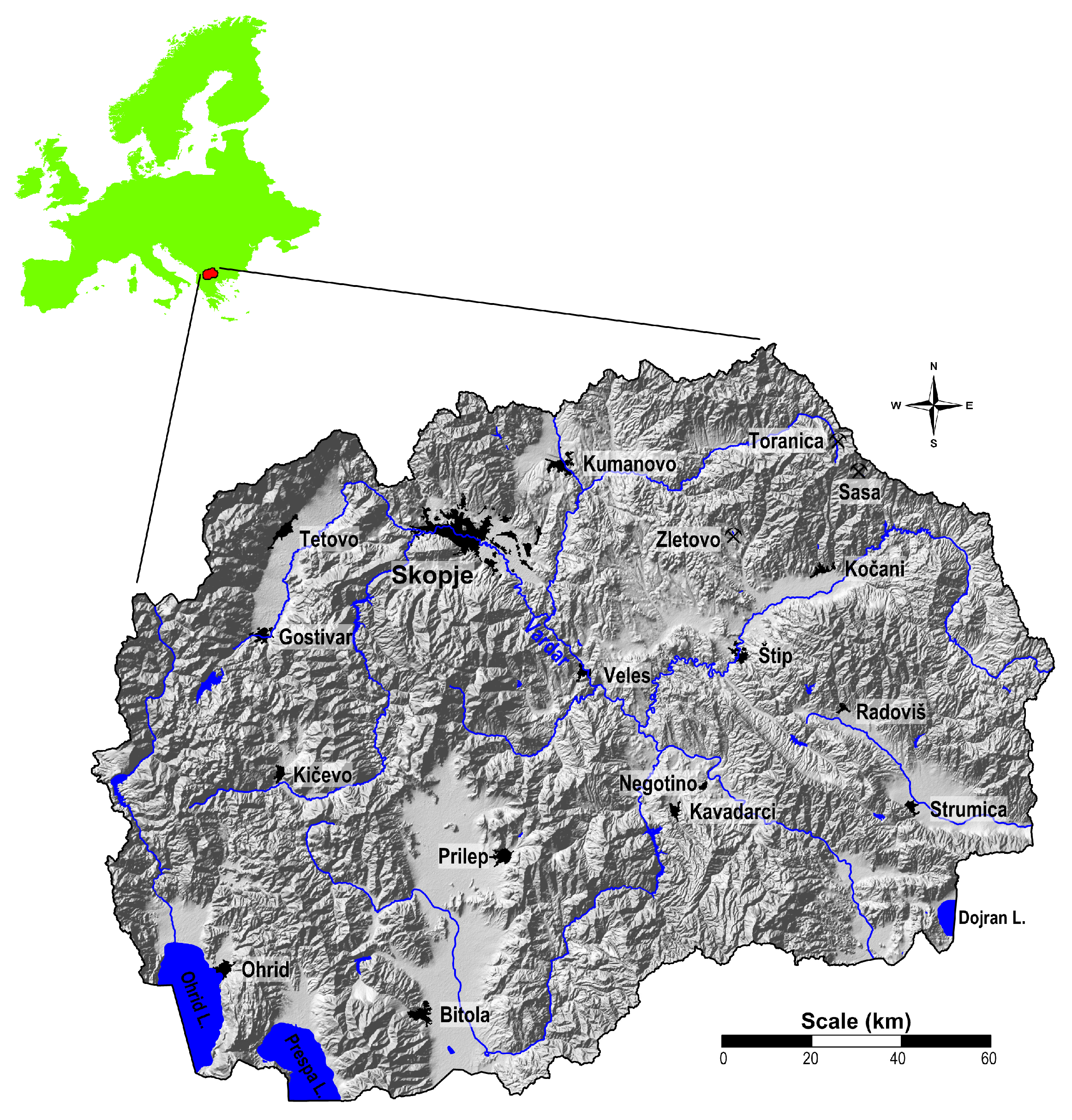
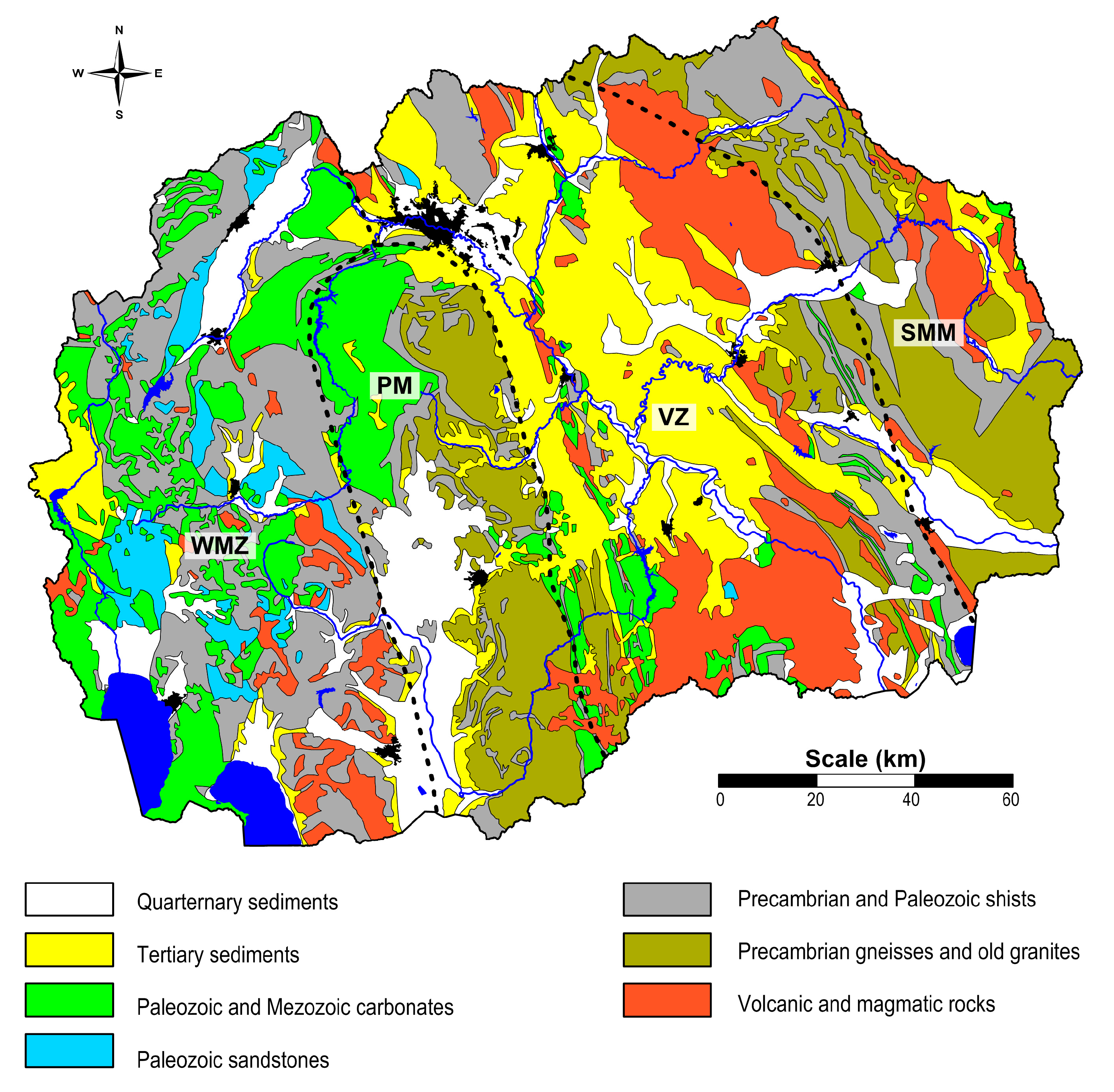
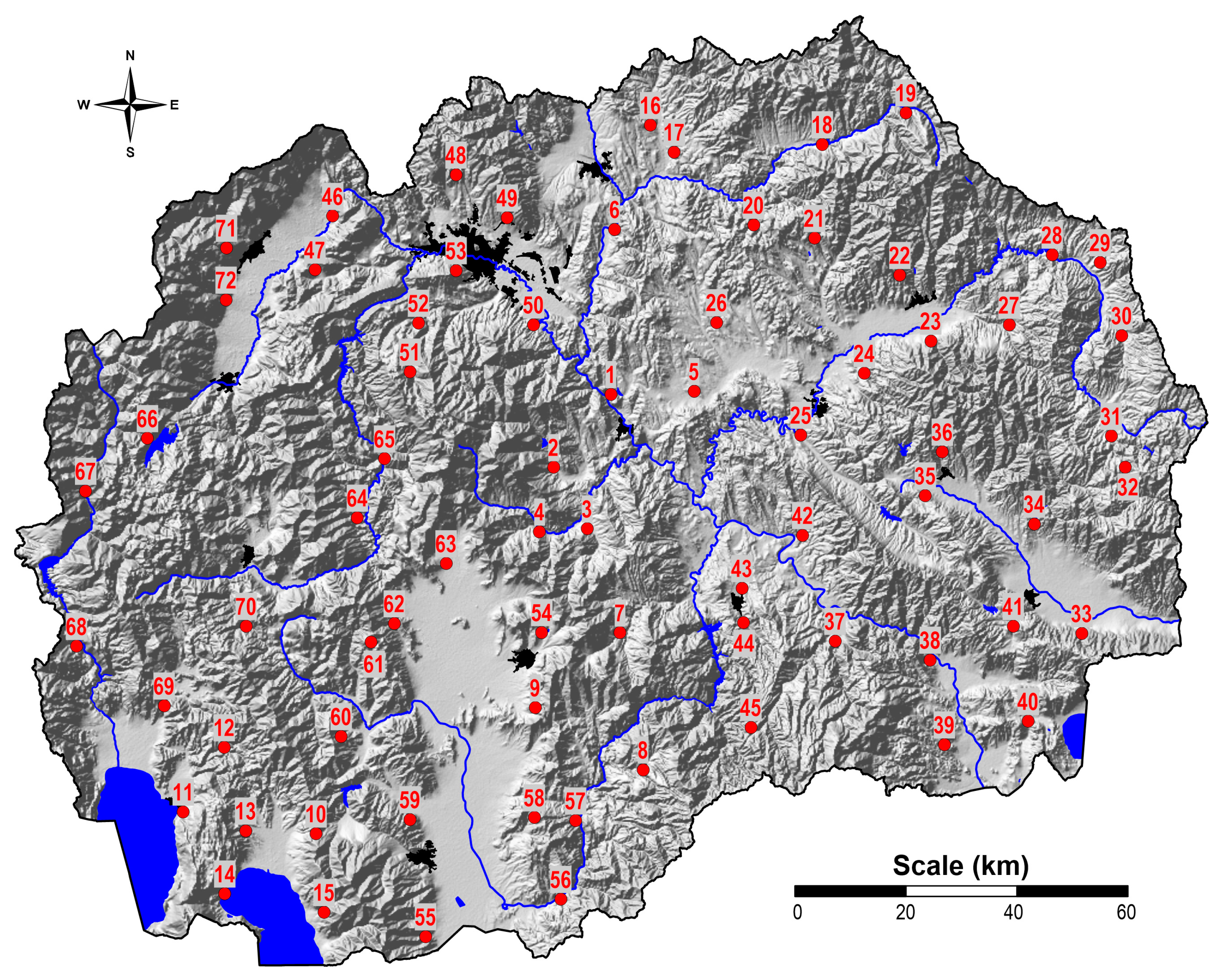
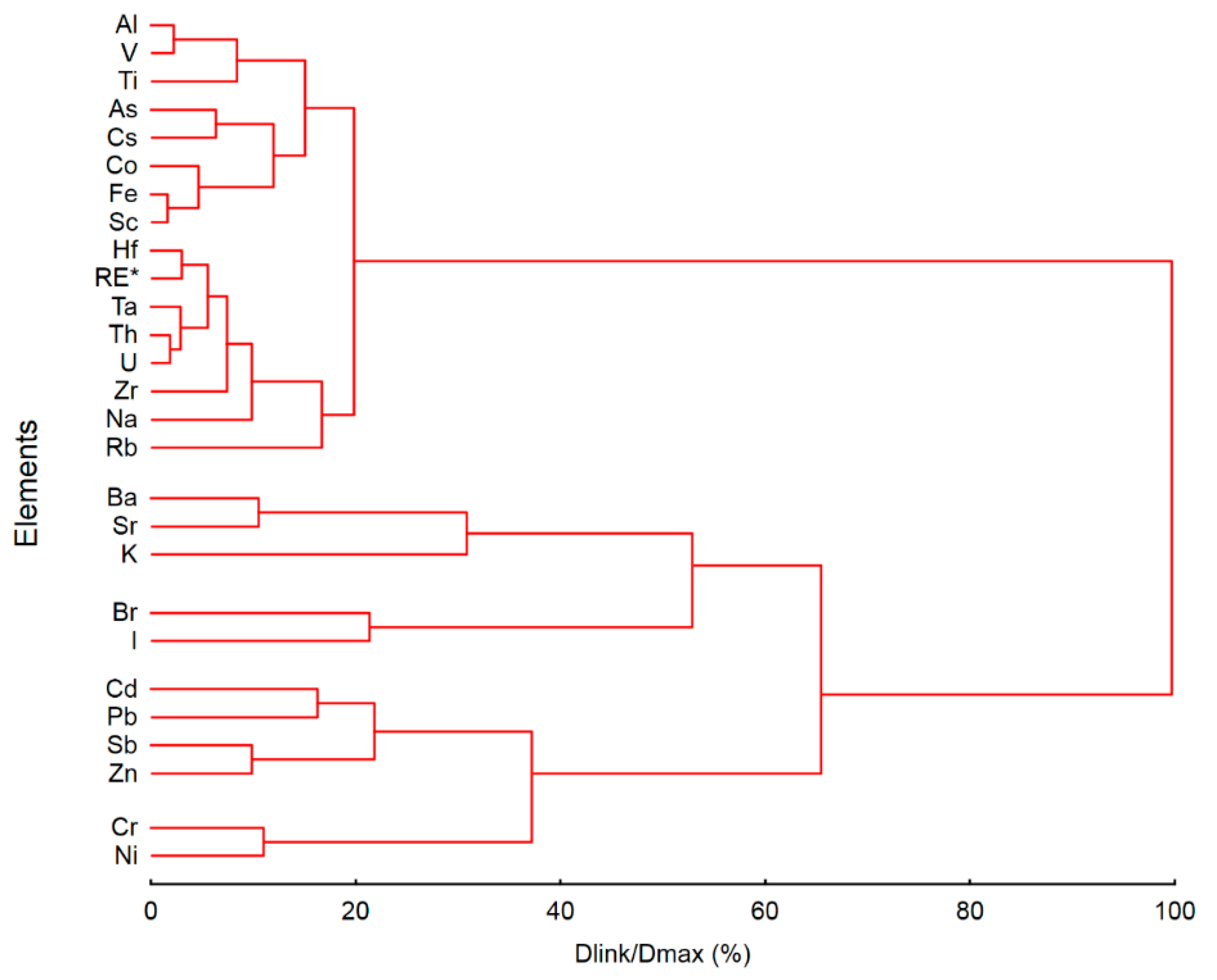
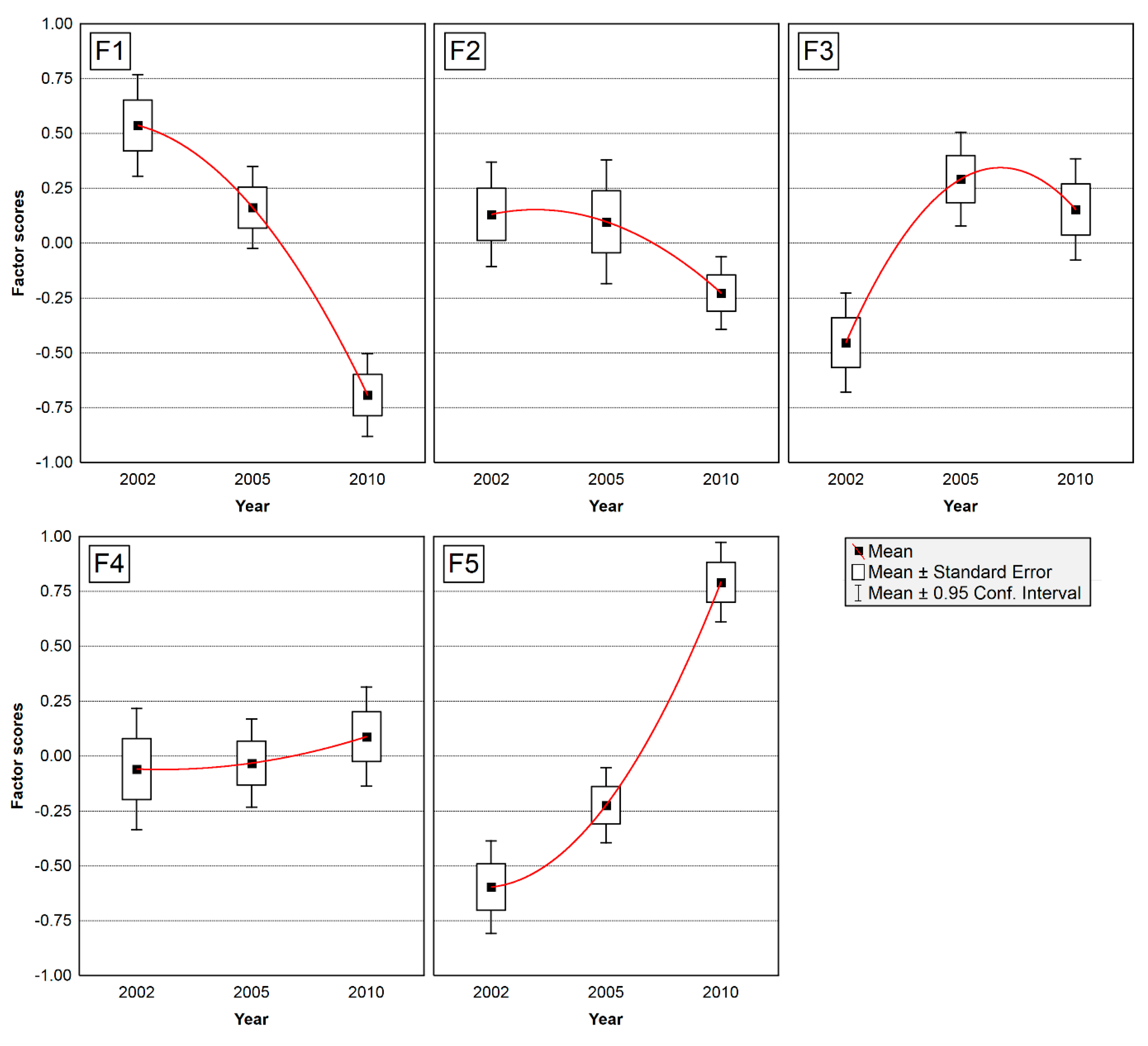
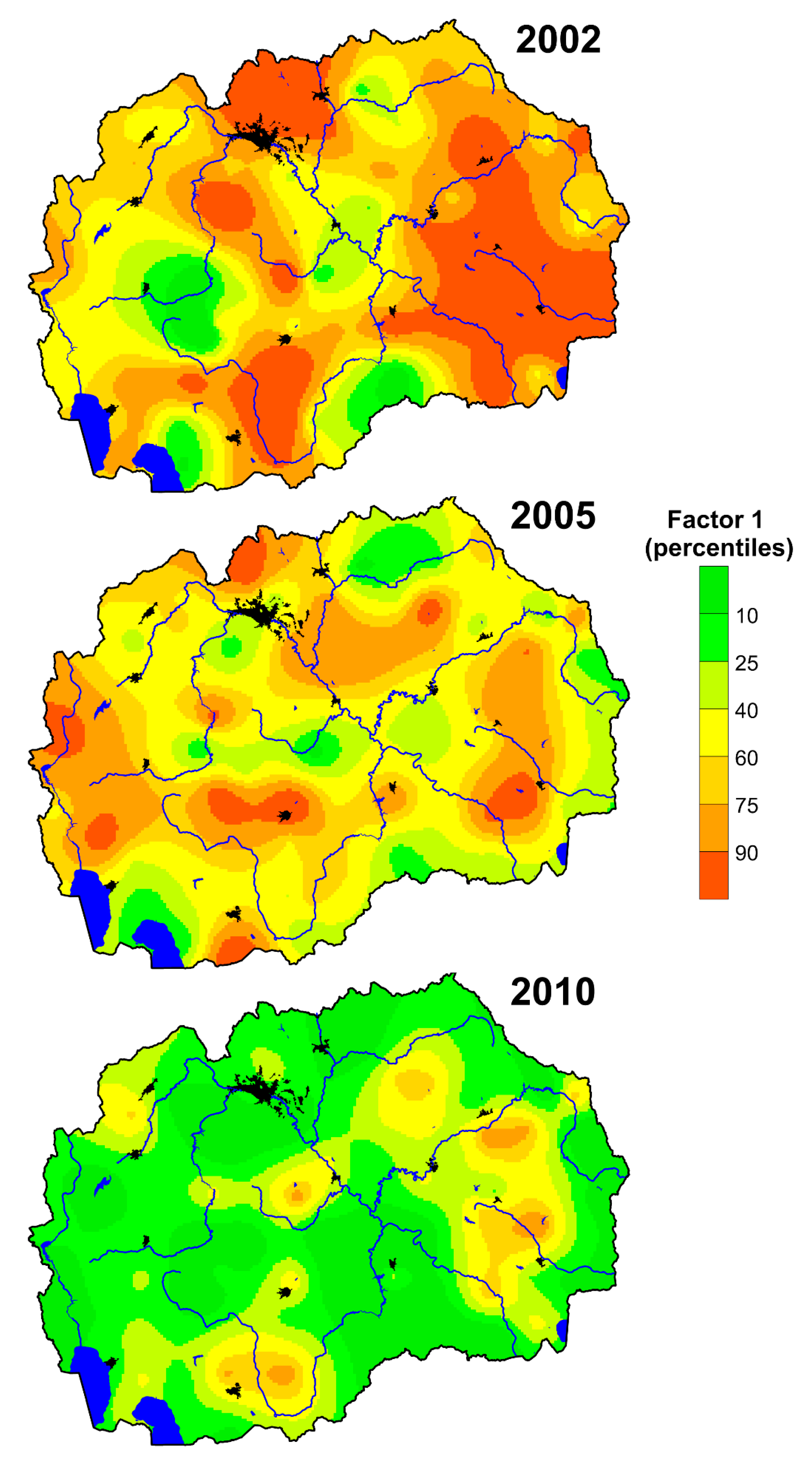
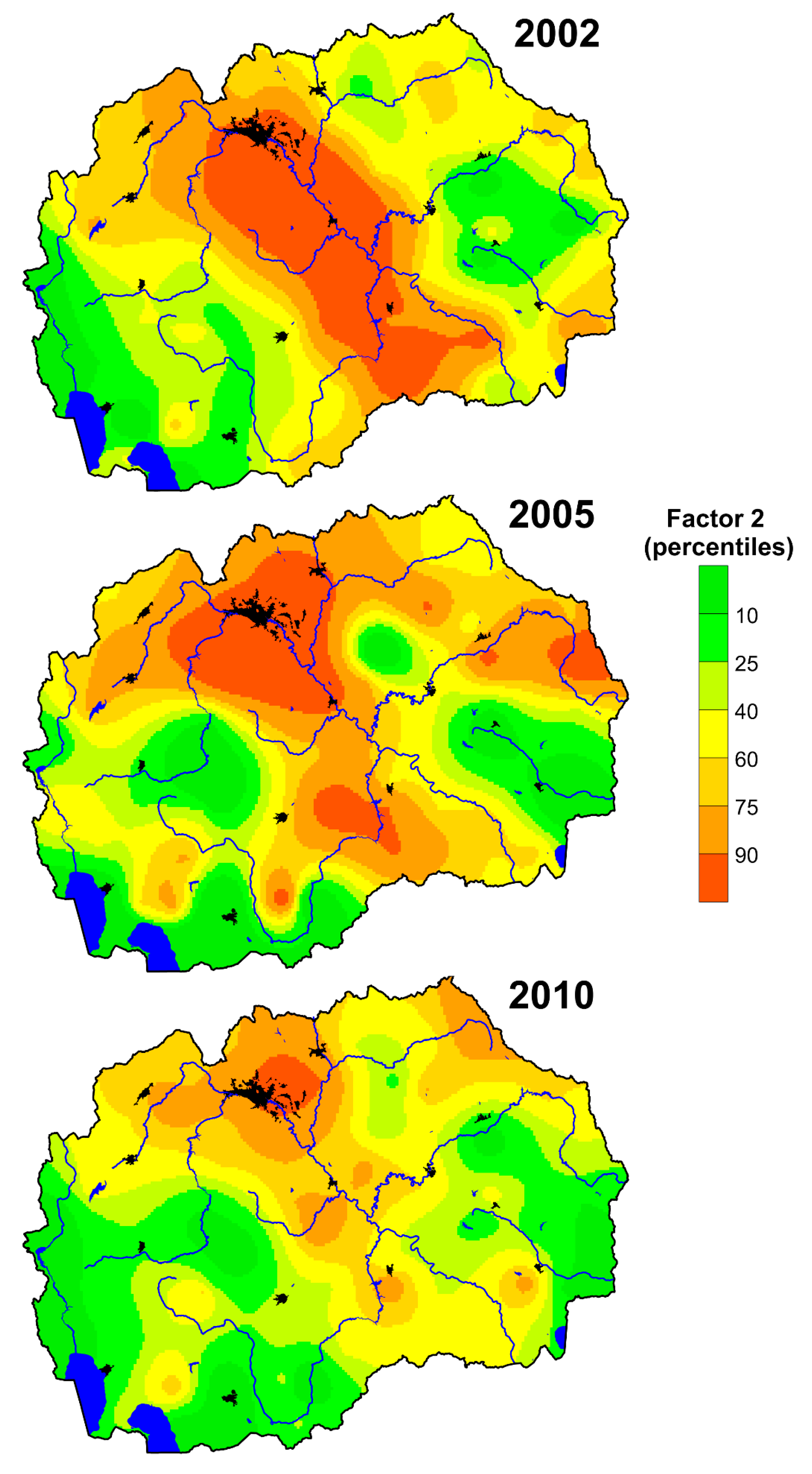
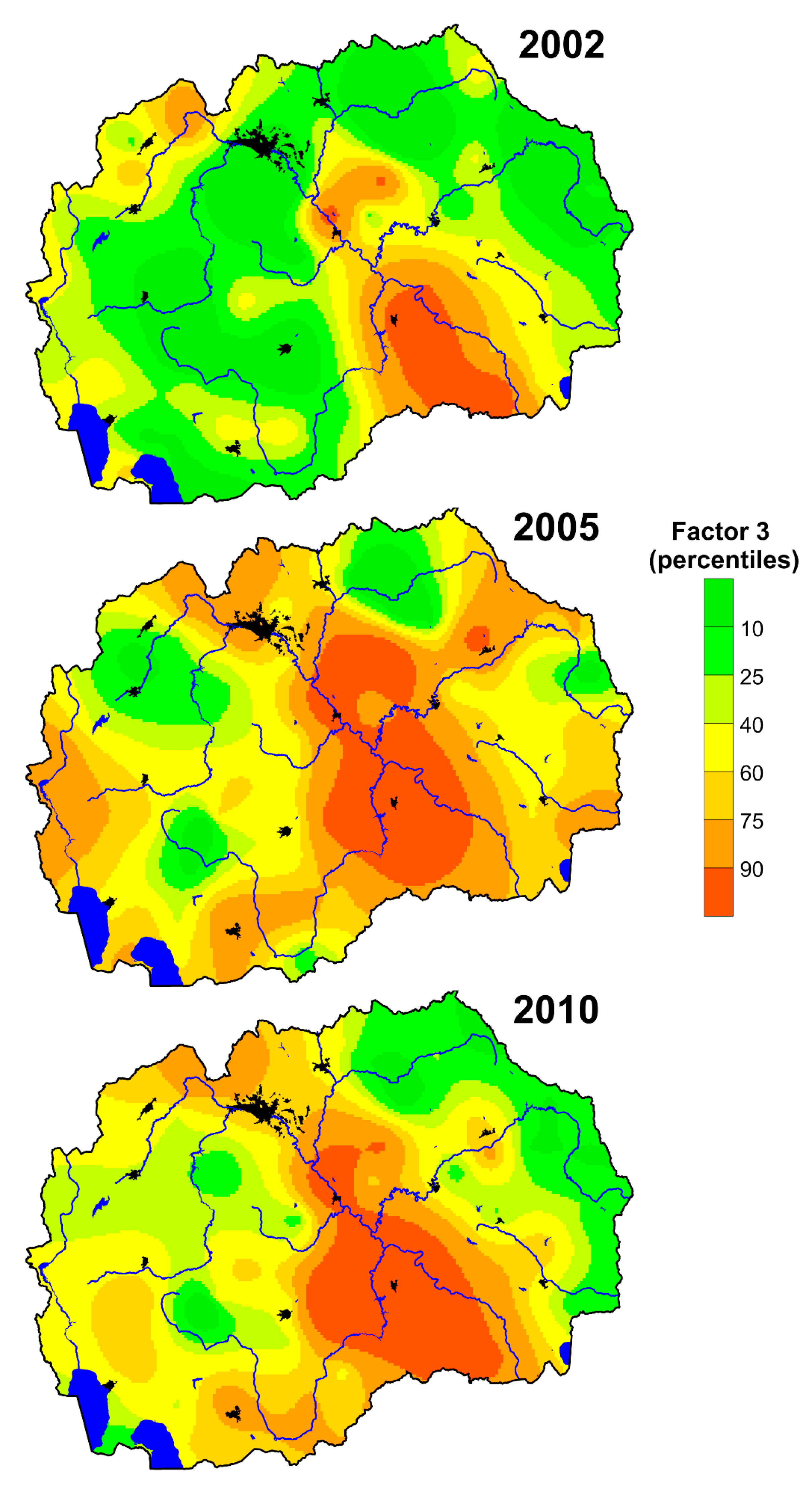
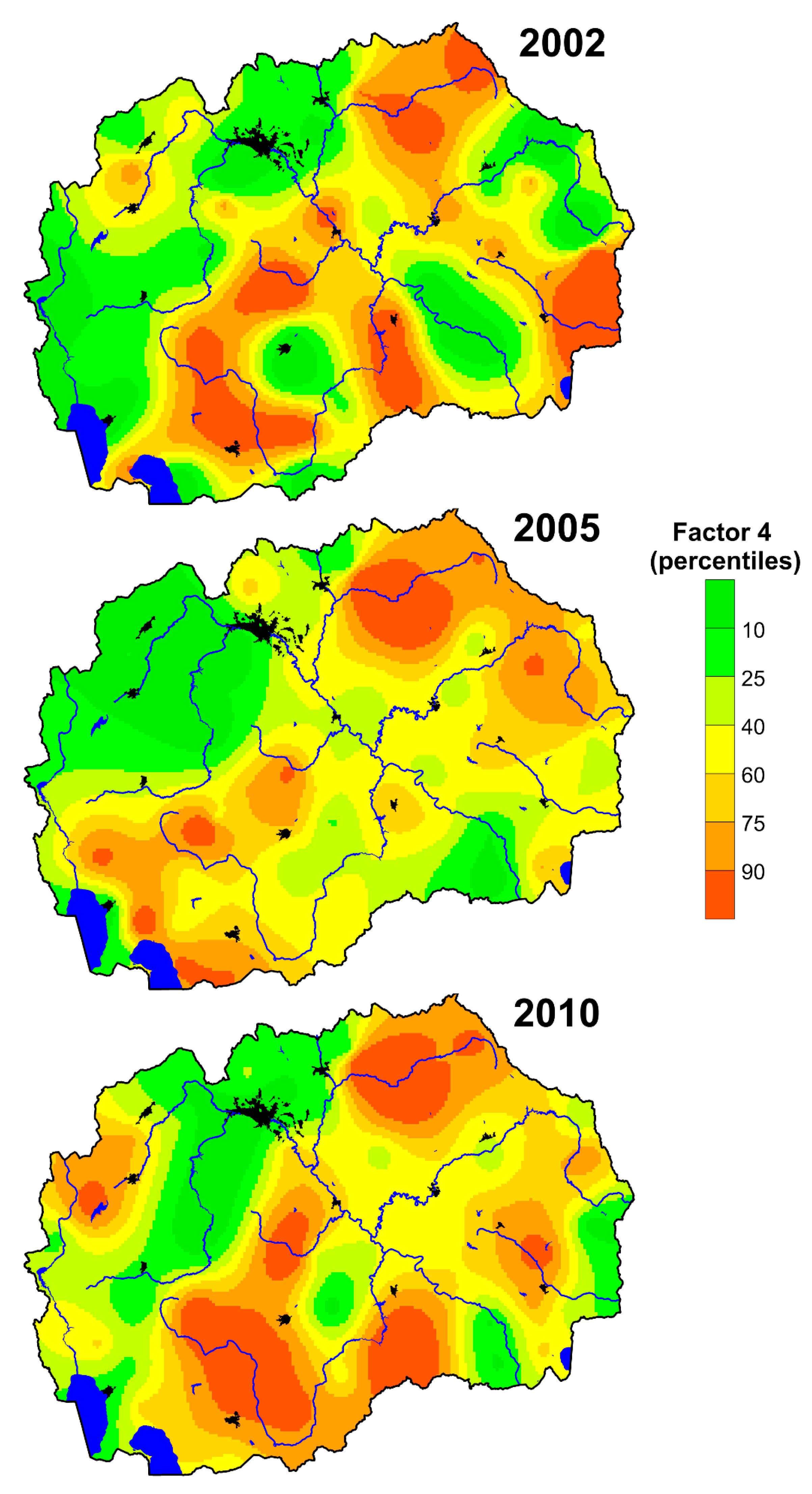
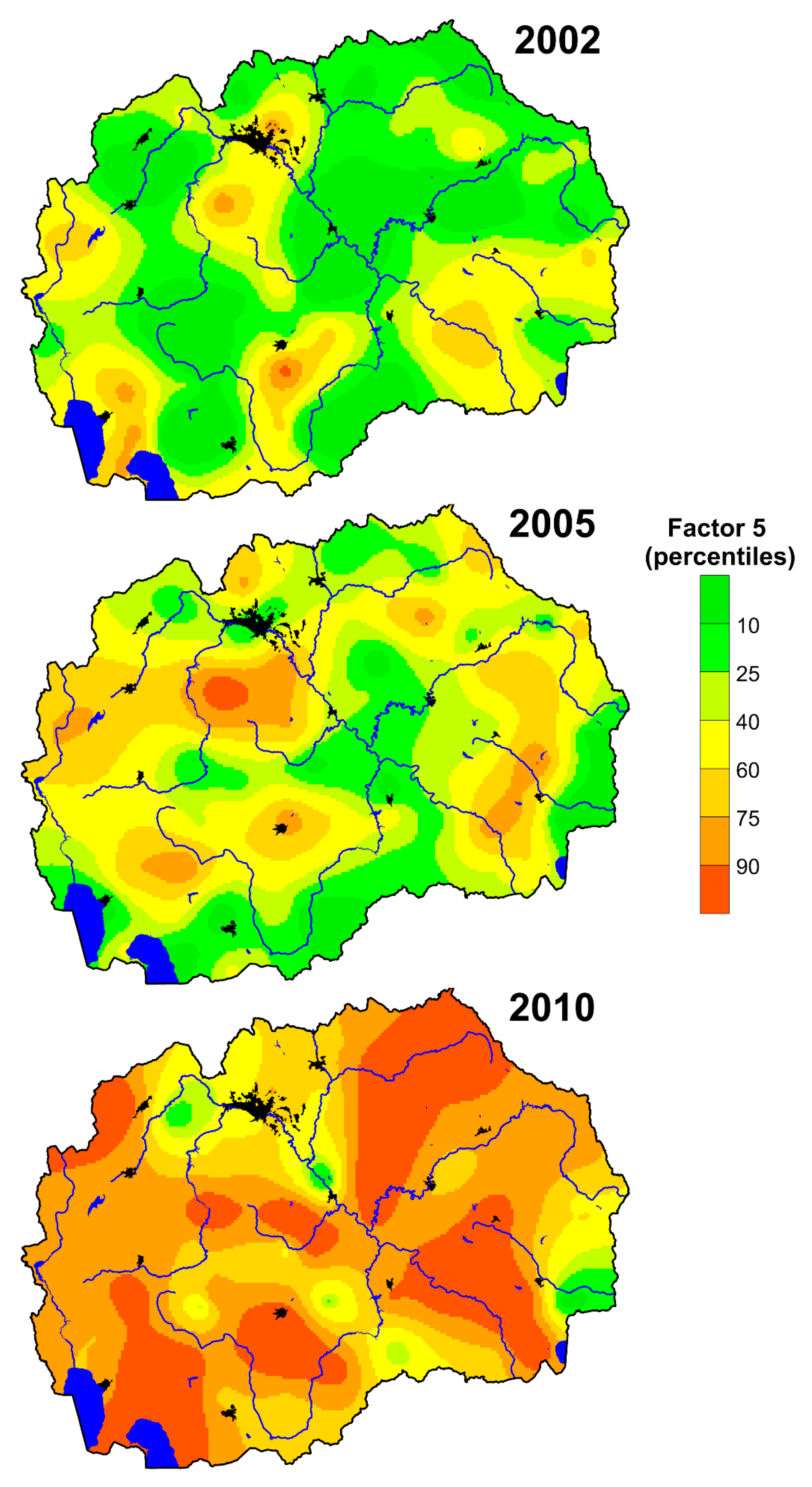
| 2002 | 2005 | 2010 | ||||||||
|---|---|---|---|---|---|---|---|---|---|---|
| Unit | XBC | Md | Min–Max | XBC | Md | Min–Max | XBC | Md | Min–Max | |
| Al | % | 0.40 | 0.38 | 0.083–1.8 | 0.37 | 0.36 | 0.15–2.6 | 0.24 | 0.24 | 0.11–0.68 |
| As | mg/kg | 0.86 | 0.80 | 0.12–8.0 | 0.69 | 0.68 | 0.18–4.3 | 0.51 | 0.48 | 0.23–1.9 |
| Ba | mg/kg | 52 | 54 | 14–260 | 52 | 53 | 18–190 | 50 | 50 | 14–360 |
| Br | mg/kg | 2.4 | 2.2 | 0.061–7.7 | 1.9 | 1.9 | 0.90–7.0 | 4.7 | 4.4 | 2.0–16 |
| Cd | mg/kg | 0.18 | 0.16 | 0.016–3.0 | 0.27 | 0.29 | 0.015–3.0 | 0.22 | 0.22 | 0.068–2.2 |
| Ce | mg/kg | 5.6 | 5.5 | 0.83–43 | 4.3 | 4.5 | 1.5–17 | 2.5 | 2.6 | 0.66–21 |
| Co | mg/kg | 1.2 | 1.1 | 0.24–14 | 1.2 | 1.1 | 0.42–5.3 | 0.77 | 0.83 | 0.27–2.9 |
| Cr | mg/kg | 7.8 | 7.9 | 2.3–120 | 7.0 | 6.8 | 2.1–82 | 6.7 | 6.5 | 2.5–35 |
| Cs | mg/kg | 0.40 | 0.38 | 0.097–1.7 | 0.34 | 0.32 | 0.13–2.3 | 0.20 | 0.20 | 0.093–0.90 |
| Eu | µg/kg | 110 | 110 | 27–480 | 71 | 66 | 6.3–480 | 71 | 79 | 8.9–260 |
| Fe | % | 0.25 | 0.24 | 0.042–1.7 | 0.23 | 0.22 | 0.10–0.81 | 0.18 | 0.19 | 0.089–0.54 |
| Hf | mg/kg | 0.29 | 0.26 | 0.050–3.8 | 0.22 | 0.21 | 0.076–1.1 | 0.17 | 0.17 | 0.085–0.70 |
| I | mg/kg | 1.2 | 1.2 | 0.36–2.8 | 1.6 | 1.7 | 0.64–3.7 | 1.6 | 1.6 | 0.51–2.9 |
| K | % | 0.83 | 0.84 | 0.29–1.8 | 0.75 | 0.75 | 0.47–1.4 | 0.66 | 0.66 | 0.36–1.0 |
| La | mg/kg | 2.5 | 2.3 | 0.50–22 | 2.4 | 2.3 | 0.97–9.1 | 1.3 | 1.4 | 0.62–9.0 |
| Na | mg/kg | 440 | 440 | 120–8700 | 360 | 360 | 140–1900 | 190 | 190 | 89–1000 |
| Ni | mg/kg | 2.6 | 2.5 | 0.089–24 | 6.1 | 5.8 | 1.8–43 | 4.0 | 4.3 | 1.0–55 |
| Pb | mg/kg | 5.8 | 6.0 | 1.5–37 | 7.4 | 7.6 | 0.10–47 | 4.5 | 4.6 | 1.9–22 |
| Rb | mg/kg | 11 | 11 | 5.0–47 | 9.4 | 9.8 | 4.0–29 | 6.6 | 6.6 | 2.2–21 |
| Sb | mg/kg | 0.19 | 0.20 | 0.040–1.4 | 0.15 | 0.15 | 0.044–0.92 | 0.09 | 0.09 | 0.044–0.22 |
| Sc | mg/kg | 0.85 | 0.74 | 0.12–6.8 | 0.72 | 0.67 | 0.30–4.6 | 0.46 | 0.44 | 0.16–1.9 |
| Sm | mg/kg | 0.44 | 0.45 | 0.072–3.4 | 0.37 | 0.35 | 0.14–2.0 | 0.27 | 0.27 | 0.11–1.5 |
| Sr | mg/kg | 31 | 32 | 12–140 | 32 | 34 | 13–140 | 34 | 34 | 12–120 |
| Ta | µg/kg | 91 | 93 | 13–790 | 78 | 77 | 31–330 | 38 | 40 | 18–170 |
| Tb | µg/kg | 60 | 62 | 9.4–560 | 55 | 53 | 15–250 | 34 | 36 | 12–190 |
| Th | mg/kg | 0.68 | 0.68 | 0.12–7.6 | 0.59 | 0.58 | 0.26–3.3 | 0.36 | 0.36 | 0.17–2.1 |
| Ti | mg/kg | 180 | 160 | 12–1400 | 230 | 220 | 86–1200 | 160 | 150 | 33–470 |
| U | mg/kg | 0.22 | 0.21 | 0.033–1.5 | 0.21 | 0.21 | 0.080–1.1 | 0.11 | 0.11 | 0.058–0.61 |
| V | mg/kg | 7.4 | 6.9 | 1.8–43 | 6.5 | 6.4 | 2.5–32 | 3.9 | 3.8 | 1.5–14 |
| Zn | mg/kg | 40 | 39 | 14–200 | 38 | 36 | 16–91 | 29 | 29 | 29 |
| Zr | mg/kg | 17 | 16 | 2.1–140 | 13 | 12 | 0.38–69 | 6.1 | 5.6 | 1.5–25 |
| XBC | XBC | XBC | t-test | t-test | t-test | F-test | ER | ER | ||||||
|---|---|---|---|---|---|---|---|---|---|---|---|---|---|---|
| Unit | 2002 | 2005 | 2010 | 2002/2005 | 2002/2010 | 2005/2010 | 2002/2005/2010 | 2005/2002 | 2010/2002 | |||||
| Al | % | 0.40 | 0.37 | 0.24 | −0.09 | NS | 4.59 | * | 5.23 | * | 15.0 | * | 0.92 | 0.61 |
| As | mg/kg | 0.86 | 0.69 | 0.51 | 2.19 | * | 5.25 | * | 2.98 | * | 13.3 | * | 0.79 | 0.59 |
| Ba | mg/kg | 52 | 52 | 50 | −0.01 | NS | 0.43 | NS | 0.47 | NS | 0.1 | NS | 1.00 | 0.96 |
| Br | mg/kg | 2.4 | 1.9 | 4.7 | 1.96 | NS | −8.68 | * | −13.06 | * | 75.7 | * | 0.77 | 1.96 |
| Cd | mg/kg | 0.18 | 0.27 | 0.22 | −1.33 | NS | −1.34 | NS | 0.39 | NS | 1.2 | NS | 1.51 | 1.20 |
| Ce | mg/kg | 5.6 | 4.3 | 2.5 | 2.05 | * | 7.12 | * | 5.66 | * | 30.0 | * | 0.77 | 0.44 |
| Co | mg/kg | 1.2 | 1.2 | 0.77 | −0.43 | NS | 3.93 | * | 5.04 | * | 12.9 | * | 1.04 | 0.67 |
| Cr | mg/kg | 7.8 | 7.0 | 6.7 | 0.77 | NS | 1.39 | NS | 0.59 | NS | 1.0 | NS | 0.90 | 0.86 |
| Cs | mg/kg | 0.40 | 0.34 | 0.20 | 0.94 | NS | 6.52 | * | 5.79 | * | 25.8 | * | 0.85 | 0.50 |
| Eu | µg/kg | 110 | 71 | 71 | 3.85 | * | 5.46 | * | 0.66 | NS | 13.4 | * | 0.62 | 0.62 |
| Fe | % | 0.25 | 0.23 | 0.18 | 0.18 | NS | 2.70 | * | 3.06 | * | 5.1 | * | 0.94 | 0.74 |
| Hf | mg/kg | 0.29 | 0.22 | 0.17 | 2.10 | * | 4.27 | * | 2.46 | * | 9.8 | * | 0.75 | 0.60 |
| I | mg/kg | 1.2 | 1.6 | 1.6 | −4.55 | * | −4.36 | * | 0.71 | NS | 14.2 | * | 1.33 | 1.35 |
| K | % | 0.83 | 0.75 | 0.66 | 1.30 | NS | 4.16 | * | 4.47 | * | 11.4 | * | 0.90 | 0.79 |
| La | mg/kg | 2.5 | 2.4 | 1.3 | 0.29 | NS | 5.65 | * | 6.21 | * | 23.4 | * | 0.95 | 0.53 |
| Na | mg/kg | 440 | 360 | 190 | 1.35 | NS | 7.56 | * | 6.98 | * | 36.0 | * | 0.83 | 0.43 |
| Ni | mg/kg | 2.6 | 6.1 | 4.0 | −6.85 | * | −3.92 | * | 3.15 | * | 24.8 | * | 2.34 | 1.54 |
| Pb | mg/kg | 5.8 | 7.4 | 4.5 | −0.76 | NS | 2.53 | * | 2.71 | * | 4.3 | * | 1.26 | 0.77 |
| Rb | mg/kg | 11 | 9.4 | 6.6 | 3.21 | * | 7.86 | * | 4.99 | * | 33.3 | * | 0.82 | 0.58 |
| Sb | mg/kg | 0.19 | 0.15 | 0.09 | 1.87 | NS | 7.57 | * | 6.41 | * | 31.5 | * | 0.80 | 0.48 |
| Sc | mg/kg | 0.85 | 0.72 | 0.46 | 0.64 | NS | 5.31 | * | 5.38 | * | 18.5 | * | 0.85 | 0.54 |
| Sm | mg/kg | 0.44 | 0.37 | 0.27 | 1.17 | NS | 3.78 | * | 2.99 | * | 8.3 | * | 0.84 | 0.62 |
| Sr | mg/kg | 31 | 32 | 34 | −0.40 | NS | −0.55 | NS | −0.20 | NS | 0.2 | NS | 1.05 | 1.10 |
| Ta | µg/kg | 91 | 78 | 38 | 1.02 | NS | 8.19 | * | 8.78 | * | 46.3 | * | 0.86 | 0.42 |
| Tb | µg/kg | 60 | 55 | 34 | 0.51 | NS | 4.46 | * | 4.56 | * | 13.6 | * | 0.92 | 0.57 |
| Th | mg/kg | 0.68 | 0.59 | 0.36 | 0.79 | NS | 5.56 | * | 5.52 | * | 20.6 | * | 0.88 | 0.52 |
| Ti | mg/kg | 180 | 230 | 160 | −2.59 | * | 0.91 | NS | 4.52 | * | 7.7 | * | 1.28 | 0.93 |
| U | mg/kg | 0.22 | 0.21 | 0.11 | 0.25 | NS | 5.87 | * | 6.59 | * | 25.6 | * | 0.93 | 0.50 |
| V | mg/kg | 7.4 | 6.5 | 3.9 | 0.71 | NS | 6.59 | * | 6.37 | * | 27.1 | * | 0.88 | 0.53 |
| Zn | mg/kg | 40 | 38 | 29 | 0.84 | NS | 4.64 | * | 4.26 | * | 13.4 | * | 0.94 | 0.72 |
| Zr | mg/kg | 17 | 13 | 6.1 | 2.65 | * | 8.38 | * | 5.37 | * | 32.7 | * | 0.78 | 0.37 |
| F1 | F2 | F3 | F4 | F5 | Comm | |
|---|---|---|---|---|---|---|
| Al | 0.90 | 0.08 | 0.19 | 0.14 | 0.17 | 91.0 |
| As | 0.78 | 0.32 | 0.21 | −0.01 | 0.07 | 76.7 |
| Co | 0.73 | 0.20 | 0.56 | 0.15 | 0.04 | 91.1 |
| Cs | 0.87 | 0.18 | 0.14 | 0.14 | −0.01 | 83.5 |
| Fe | 0.84 | 0.15 | 0.36 | 0.20 | 0.19 | 93.2 |
| Hf | 0.90 | 0.04 | 0.13 | 0.24 | 0.15 | 90.1 |
| Na | 0.80 | 0.11 | 0.11 | 0.33 | −0.18 | 80.3 |
| Rb | 0.69 | 0.18 | −0.16 | 0.40 | −0.13 | 71.3 |
| Sc | 0.90 | 0.11 | 0.29 | 0.12 | 0.06 | 93.1 |
| Ta | 0.94 | 0.10 | 0.07 | 0.16 | −0.03 | 92.1 |
| Th | 0.91 | 0.12 | 0.09 | 0.24 | 0.08 | 92.0 |
| Ti | 0.72 | 0.00 | 0.27 | 0.21 | 0.27 | 70.6 |
| U | 0.89 | 0.15 | 0.11 | 0.27 | 0.04 | 90.5 |
| V | 0.87 | 0.19 | 0.23 | 0.03 | 0.07 | 85.5 |
| Zr | 0.89 | 0.06 | 0.03 | 0.17 | −0.06 | 82.6 |
| RE* | 0.90 | 0.08 | 0.17 | 0.24 | 0.16 | 91.7 |
| Cd | −0.08 | 0.82 | 0.13 | 0.12 | 0.11 | 73.2 |
| Pb | 0.22 | 0.83 | 0.02 | −0.06 | 0.18 | 77.8 |
| Sb | 0.59 | 0.64 | 0.19 | −0.10 | −0.11 | 82.9 |
| Zn | 0.33 | 0.73 | 0.33 | 0.12 | −0.20 | 81.3 |
| Cr | 0.53 | 0.22 | 0.69 | 0.05 | 0.12 | 81.8 |
| Ni | 0.18 | 0.25 | 0.86 | 0.05 | 0.21 | 87.9 |
| Ba | 0.43 | −0.00 | −0.03 | 0.75 | 0.26 | 81.9 |
| K | 0.20 | 0.11 | 0.01 | 0.68 | −0.39 | 67.0 |
| Sr | 0.31 | −0.02 | 0.22 | 0.70 | 0.24 | 69.2 |
| Br | −0.04 | 0.03 | 0.05 | 0.08 | 0.81 | 66.8 |
| I | 0.24 | 0.11 | 0.19 | −0.00 | 0.72 | 63.1 |
| Prp.Totl | 47.3 | 10.4 | 8.6 | 8.5 | 7.0 | 81.8 |
| Expl.Var | 12.78 | 2.81 | 2.33 | 2.29 | 1.88 | |
| EigenVal | 15.34 | 2.50 | 0.98 | 1.34 | 1.92 |
© 2020 by the authors. Licensee MDPI, Basel, Switzerland. This article is an open access article distributed under the terms and conditions of the Creative Commons Attribution (CC BY) license (http://creativecommons.org/licenses/by/4.0/).
Share and Cite
Barandovski, L.; Stafilov, T.; Šajn, R.; Frontasyeva, M.; Bačeva Andonovska, K. Atmospheric Heavy Metal Deposition in North Macedonia from 2002 to 2010 Studied by Moss Biomonitoring Technique. Atmosphere 2020, 11, 929. https://doi.org/10.3390/atmos11090929
Barandovski L, Stafilov T, Šajn R, Frontasyeva M, Bačeva Andonovska K. Atmospheric Heavy Metal Deposition in North Macedonia from 2002 to 2010 Studied by Moss Biomonitoring Technique. Atmosphere. 2020; 11(9):929. https://doi.org/10.3390/atmos11090929
Chicago/Turabian StyleBarandovski, Lambe, Trajče Stafilov, Robert Šajn, Marina Frontasyeva, and Katerina Bačeva Andonovska. 2020. "Atmospheric Heavy Metal Deposition in North Macedonia from 2002 to 2010 Studied by Moss Biomonitoring Technique" Atmosphere 11, no. 9: 929. https://doi.org/10.3390/atmos11090929
APA StyleBarandovski, L., Stafilov, T., Šajn, R., Frontasyeva, M., & Bačeva Andonovska, K. (2020). Atmospheric Heavy Metal Deposition in North Macedonia from 2002 to 2010 Studied by Moss Biomonitoring Technique. Atmosphere, 11(9), 929. https://doi.org/10.3390/atmos11090929








